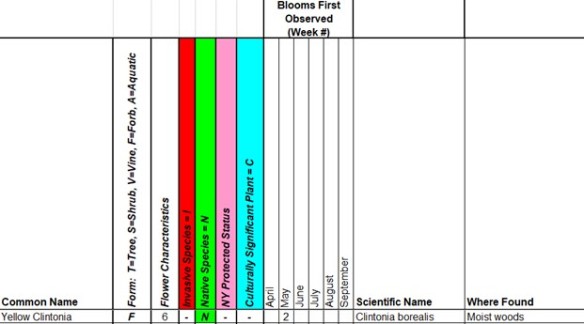This week, I’m featuring Yellow Clintonia (Clintonia borealis) as one of our local wildflowers that begins to bloom at this time.
The plant was named in honor of the former governor of New York, DeWitt Clinton (1769-1828). The beautiful fruits that each plant bears are noted for their extraordinary true-blue color, which is why this plant has another common name, Blue-bead Lily. The species name, ‘borealis,’ means “of the north,” which alludes to the fact that the species tends to thrive in the boreal forests of eastern Canada and northeastern United States.
Identification Tips:
Yellow Clintonia grows from six to 15 inches tall. Each plant is anchored by a basal clump of three to five thick, shiny, bright green oval leaves with smooth edges. The glossy leaves can reach 12 inches in length, but are more commonly six to eight inches long, with a prominent central vein. When cut or crushed, the leaf imparts a distinct cucumber aroma.
A leafless stem rises from those basal leaves and is topped by a cluster of 3-6 yellowish-green, drooping, bell-like flowers. Each flower is about 3/4″ wide, with petal-like sepals.
A single berry eventually replaces each flower. Berries transition from green to white, and ultimately to a deep porcelain blue. The berries are about a quarter inch wide, yet, because of their striking color, they stand out in sharp contrast to the greens and browns of the surrounding forest floor.

Photo credit: (c) 2002 Peter M. Dziuk, https://www.minnesotawildflowers.info/flower/bluebead
Yellow Clintonia plants are often found growing together in colonies.
Folklore:
Hunters in North Quebec were said to have rubbed their traps with the roots of this plant because bears are attracted to its odor. According to a Mi’kmaq tale, when a grass snake eats a poisonous toad, it slithers in rapid circles around a shoot of the Blue-bead Lily to transfer the poison to the plant.
Culinary and Medicinal Uses:
The young leaves may be chopped and added to salads, but only if harvested before they fully unfurl in the spring. They reportedly have a slightly sweetish cucumber flavor. However, the fruit is mildly toxic.
Yellow Clintonia has limited use as a medicinal plant. The roots and leaves are reported to possess antifungal properties. Some American Indians made some use of this plant in the treatment of skin problems. For instance, the Algonquin applied a poultice of fresh leaves to open wounds, infections, and ulcers and the Chippewa used a poultice of fresh leaves for burns. Additionally, the Iroquois used a decoction of the plant as a heart medication.
Wildlife Value:
The most common pollinators of Yellow Clintonia are Bumblebees (Bombus ternarius and B. vagans). These flowers are also visited by Canadian Tiger Swallowtail (Papilio canadensis), Syrphid flies, and Lasioglossum sweat bees.
Eastern Chipmunks (Tamias striatus) relish the ripened berries.
Dense colonies of these plants provide excellent habitat for the Ovenbird (Seiurus aurocapilla), a migratory warbler that nests on the ground.
Where Found Locally:


